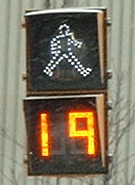Ever wonder what happens when you push the button at a crosswalk? Or why some lights seem to change instantly, while others will leave you waiting to cross for what seems like an eternity?
(Spoiler: In Toronto, that eternity is probably only about two minutes.)
Metro spoke with Linda Lee, a supervisor with the city’s Traffic Management Centre, to get the skinny on what exactly “push to cross” means.
According to Lee, Toronto has about 2,300 controlled crosswalks. Of those, 70 per cent are what’s known as “semi-actuated.” Typically found at the intersection of a major thoroughfare and a residential street, these signals only change when a car pulls up or when a pedestrian pushes the crossing button.
Depending on traffic volumes, Lee said you can expect to wait anywhere from six seconds to two minutes for the signal to change once the button’s been pressed.
Once the walk light is on, the amount of time you have to cross depends on the size of the intersection. Generally speaking, Lee said pedestrians are assumed to be travelling at around one metre per second.
Amusingly, about 10 per cent of crosswalk buttons in Toronto don’t have any effect on traffic signals at all. At these “fixed time” intersections, Lee said the buttons are only there so pedestrians with visual impairments can activate the audible crossing signal.
One in three crosswalks in Toronto are equipped with accessible audio signals, Lee said. They don’t sound unless someone has held the button down for three seconds or more.
The signals make a “cuckoo” noise for north-south crossings and a “chirping” sound for east-west ones, said Lee.
Most crosswalks are equipped with a countdown, showing how much time is left before a signal change. However, just because a countdown is visible doesn’t mean the light is going to change, Lee said. At the end of the countdown, some crosswalks will simply reset if no one has hit the button.
“So, if you see a button, the best thing to do is push it,” Lee said.









